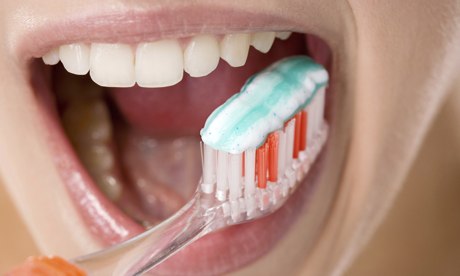There are three main toothpaste ingredients that may be made of nano-sized particles, so let's brush up on the facts
 |
White stuff … a woman brushing her teeth. Photograph: Alamy
|
The Consumer Products Inventory lists more than 1,600 products that are identified by the manufacturer as containing nanoparticles. So let's take a look at what's inside your household items. This week: toothpaste.
There are three main toothpaste ingredients that may be made of nano-sized particles:
Hydroxyapatite, cavity filler
Hydroxyapatite is a lattice of calcium found naturally in teeth and bones. It helps prevent tooth pain associated with sensitivity. Coating the teeth and slipping into tiny cracks, it breaks down in response to acid before your enamel does, protecting the teeth from decay and cavities.
Hydroxyapatite also provides a source of calcium and phosphate ions which, combined with fluoride, help to remineralise the tooth surface.
Silver, bacteria killer
Silver nanoparticles are proven to have antibacterial properties, reducing the risk of gum disease and bad breath caused by bacteria in the mouth. Its distribution in toothpaste remains largely limited to manufacturers based in Asia, though such products can be purchased online. Like titanium dioxide, it is widely used in a number of other products, including clothing and plasters.
Titanium dioxide, whitener
Titanium dioxide is an intensely white pigment. It has a high refractive index, which means it scatters light to create a very white product. Titanium dioxide is widely used in toothpaste, but often the particles used are not small enough to be defined as nanoparticles.
Since July 2013, EU cosmetics regulation has demanded that all nanoparticles are labelled on the ingredient list. Despite publishingguidance on assessing safety, there are no formal testing requirements in the legislation.
A number of popular brands still do not contain nanoparticles. From those we contacted, Oral-B and Boots responded to confirm that their products do not contain nanoparticles, while Colgate states on its website that its products are currently nanoparticle-free.
Dr Robert Hill, from Queen Mary University of London, who helped develop a toothpaste containing nanoparticles of hydroxyapatite, explains that many nanoparticles occur naturally: "Silica particles are found in many food stuffs and, in fact, nanosilica particles have been put into cosmetics and household products for more than 40 years with no adverse responses. People just aren't aware of this, because back then no one talked about nanotechnology."
Research into the safety of nanoparticles in toothpaste and other everyday products is ongoing. Widely used silver nanoparticles are an area of particular concern, with studies showing that this substance could make its way from the mouth to accumulate other organs of the body.
Nina Quadros, associate director for Virginia Tech's Center for Sustainable Nanotechnology, does not think we are far from establishing safety regulations for nanotechnology in the cosmetics industry: "It's important that regulations are developed based on the characteristics which may affect toxicity, such as composition, size, chemical stability, and so on, and also based on each product's usage scenarios and how likely they are to enter the human body. Nanotechnology has promising potential, which can be explored responsibly by utilising its benefits while minimising risks to human health and the environment."
Fonte: The Guardian
